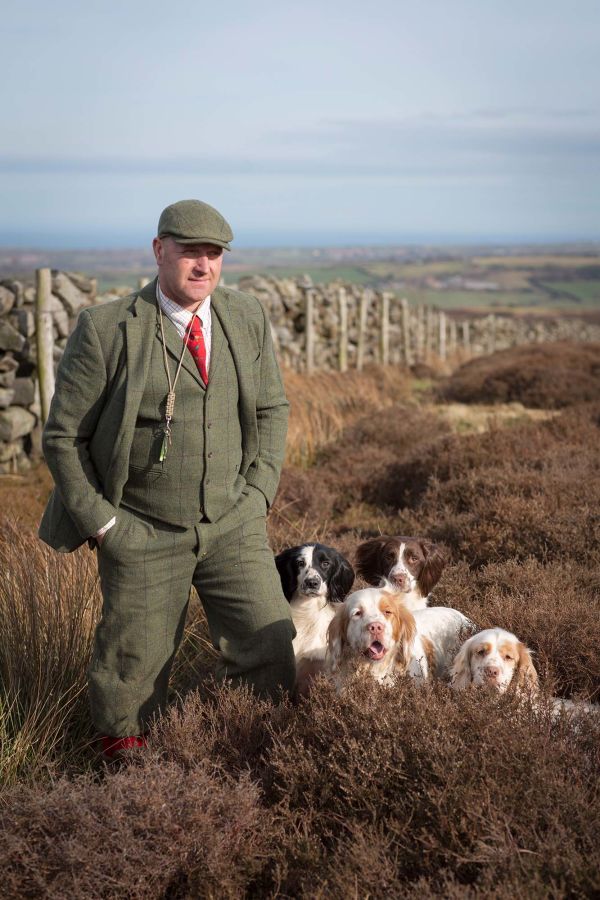As a gamekeeper Andy Parker spends his working life high on the heather moorland. He needs his dogs to deliver all year round which makes his passionate advocacy for the noble Clumber spaniel even more convincing:
Photos: Scott Wicking

#closer2hunting
Andy Parker
“I actually have 11 Clumbers at the moment as well as a few springers. In April and May time we start with the spring grouse counts to establish the number of adult pairs. I use the Clumbers and springers two at a time, looking for the adult pairs of grouse. When they flush a pair, we mark on a plan where they have flushed them. And we do the count in the same area each year, so we have a good comparison year-on-year. We might do 16 different counts in total during this period, with two a day; one in the early morning and one in the evening to protect the dogs from the heat of the day, even in spring. It’s hard work in the heather and we have to be very careful not to overwork the dogs on this terrain.”
Grouse needs heather
And the gamekeeper on the North Yorkshire Moors continues: “The grouse population is dependent on the heather quality. We are quite close to the coast so we sometimes get bitter northerly winds, which effectively cause frostbite in the heather; it can be that severe. Dry weather at the wrong time of year can also have a bad impact. We expect our grouse chicks to hatch in the middle of May so, having done the pairs count in spring, we then go again in the summer to do the brood count to get an idea of how many young on average each pair has produced. More than six young per pair is considered good, and double figures would indicate a very successful breeding season indeed.”

“This is all done with the dogs and when they flush the adult pair we watch with the binoculars (SWAROVSKI OPTIK of course) to count the number of young. We use these numbers to multiply up and get an average for the whole moor. We are on the moor all the time, so apart from the spring and summer counts we will be keeping a very close eye on the broods as they grow.”


Trusting their nose
Some gamekeepers prefer labradors and increasingly HPR (hunt, point and retrieve) breeds are popular too, but for Andy nothing beats a Clumber: “If we are in the beating line the dogs have to push through knee-deep heather walking for up to three miles a drive and there could be five or six drives in a day. Make no mistake this is hard work for the dogs. But to be honest I think this is where the Clumbers come into their own. They use their noses to conserve energy in a smart way and for me they are the perfect dogs for the uplands. Instead of just covering every inch of the area in a blanket coverage approach they will use and trust their nose to take them to where the grouse are. Springer spaniels famously have tremendous energy, and they are brilliant dogs. But often you will see halfway through a drive they can start to lose their enthusiasm because they get tired, having wasted so much energy covering every inch of the ground.”


“If we are picking-up we will be a long way back from the butts where the shooting takes place and laid in the heather and the dogs need to be steady. If they are sat up on the skyline the grouse can see them as they fly towards the Guns and this can deter them. We pick any wounded birds during the drive and then sweep up afterwards to collect all the dead game from the heather right up to the stone butts where the Guns have been. For picking-up I think Clumbers and springers are equal. The Clumbers are great at taking a line when they get the scent of a bird in the heather. They will follow the line and not be distracted and will go 200 or 300 yards. At that moment nothing else matters to them and I will have to admit they can be a bit stubborn in that sense. But they get the job done at the end of the day. I love working with my dogs in this beautiful and challenging environment and I certainly couldn’t do it without them.”

Sobre el autor:
Will Hetherington
Will Hetherington lleva 22 años inmerso en el periodismo deportivo de campo del Reino Unido. Fue editor de Shooting Gazette durante 13 años, entre 2004 y 2017, y ahora es editor y escritor independiente. Una de sus principales funciones es la de editor de Gundog Journal, una revista bimensual líder en el mundo de los perros de caza publicado por Fieldsports Press. Con dos fieles labradores siempre a su lado, entiende la compañía que ofrecen los perros de caza, ya sea en el campo en busca de aves o relajándose en casa con el fuego encendido y una copa de vino tinto a mano.



















